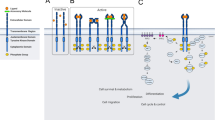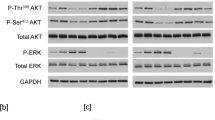Abstract
Activation of tyrosine kinase receptors is associated with human tumors. Tumorigenic versions of several RTKs, such as Ret, Kit and Met carry activating mutations at highly conserved residues of the tyrosine kinase domain. We have investigated the effect of some of these mutations on the NTRK1/NGF receptor, for which no naturally occurring activating point mutations have been so far detected. We introduced the following mutations in NTRK1 tyrosine kinase domain: (i) D668N equivalent to Met D1246N associated to HPRC; (ii) D668V modelled on Kit D816V found in mastocytosis; (iii) M688T corresponding to Ret M918T associated to the cancer syndrome MEN2B. The Met-like mutation rendered the NTRK1 receptor more responsive to ligand, as observed for the corresponding mutation in Met. On the contrary the Kit-like D668V resulted as neutral mutation. Surprisingly, the MEN2B-like M688T completely abrogated NTRK1 receptor activity, resulting as a loss of function mutation. Our results show that the mutations tested, although involving conserved amino acids in highly homologous regions, exert distinct effects in different receptors, and suggest a very peculiar auto-inhibitory mechanism for NTRK1.
This is a preview of subscription content, access via your institution
Access options
Subscribe to this journal
Receive 50 print issues and online access
$259.00 per year
only $5.18 per issue
Buy this article
- Purchase on Springer Link
- Instant access to full article PDF
Prices may be subject to local taxes which are calculated during checkout



Similar content being viewed by others

References
Cordon-Cardo C, Tapley P, Jing S, Nanduri V, O'Rorke E, Lamballe F, Kovary K, Klein R, Jones KR, Reichardt LF, Barbacid M . 1991 Cell 66: 173–183
Cunningham ME, Greene LA . 1998 EMBO J. 17: 7282–7293
Descamps S, Lebourhis X, Delehedde M, Boilly B, Hondermarck H . 1998 J. Biol. Chem. 273: 16659–16662
Furitsu T, Tsujimura T, Tono T, Ikeda H, Kitayama H, Koshimizu U, Sugahara H, Butterfield JH, Ashman LK, Kanayama Y . 1993 J. Clin. Invest. 92: 1736–1744
Greco A, Mariani C, Miranda C, Lupas A, Pagliardini S, Pomati M, Pierotti MA . 1995 Mol. Cell. Biol. 15: 6118–6127
Greco A, Villa R, Fusetti L, Orlandi R, Pierotti MA . 2000 J. Cell. Physiol. 182: 127–133
Hanks SK, Quinn AM, Hunter T . 1988 Science 241: 42–52
Hubbard SR . 1997 EMBO J. 16: 5572–5581
Indo Y . 2001 Hum. Mutat. 18: 462–471
Kaplan DR, Miller FD . 2000 Curr. Opin. Neurobiol. 10: 381–391
Maritano D, Accornero P, Bonifaci N, Ponzetto C . 2000 Oncogene 19: 1354–1361
Miknyoczki SJ, Lang D, Huang L, Klein-Szanto AJ, Dionne CA, Ruggeri BA . 1999 Int. J. Cancer 81: 417–427
Miranda C, Di Virgilio M, Selleri S, Zanotti G, Pagliardini S, Pierotti MA, Greco A . 2002 J. Biol. Chem. 277: 6455–6462
Nagata H, Worobec AS, Oh CK, Chowdhury BA, Tannenbaum S, Suzuki Y, Metcalfe DD . 1995 Proc. Natl. Acad. Sci. USA 92: 10560–10564
Pierotti MA, Bongarzone I, Borrello MG, Greco A, Pilotti S, Sozzi G . 1996 Genes Chrom. Cancer 16: 1–14
Reuther GW, Lambert QT, Caligiuri MA, Der CJ . 2000 Mol. Biol. Cell 20: 8655–8666
Santoro MM, Penengo L, Minetto M, Orecchia S, Cilli M, Gaudino G . 1998 Oncogene 17: 741–749
Schmidt L, Duh FM, Chen F, Kishida T, Glenn G, Choyke P, Scherer SW, Zhuang Z, Lubensky I, Dean M, Allikmets R, Chidambaram A, Bergerheim URF, Feltis JT, Casadevall C, Zamarron A, Bernues M, Richard S, Lips CJ, Walther MM, Tsui LC, Geil L, Orcutt ML, Stackhouse T, Zbar B, Lipan J, Slife L, Brauch H, Decker J, Niehans G, Hughson MD, Moch H, Storkel S, Lerman MI, Lineham WM . 1997 Nat. Genet. 16: 68–73
Songyang Z, Carraway III KL, Eck MJ, Harrison SC, Feldman RA, Mohammadi M, Schlessinger J, Hubbard SR, Smith DP, Eng C, Lorenzo MJ, Ponder BAJ, Mayer BJ, Cantley LC . 1995 Nature 373: 536–539
Tagliabue E, Ghirelli C, Lombardi L, Castiglioni F, Asnaghi L, Longhi C, Borrello MG, Aiello P, Menard S . 1999 Int. J. Biol. Markers 14: 68–72
Till JH, Ablooglus AJ, Frankel M, Bishop SM, Kohanskii RA, Hubbard SR . 2001 J. Biol. Chem. 276: 10049–10055
Tsujimura T, Furitsu T, Morimoto M, Isozaki K, Nomura S, Matsuzawa Y, Kitamura Y, Kanakura Y . 1994 Blood 83: 2619–2626
van Heyningen V . 1994 Nature 367: 319–320
Weeraratna AT, Dalrymple SL, Lamb JC, Denmeade SR, Miknyoczki SJ, Dionne CA, Isaacs JT . 2001 Clin. Cancer Res. 7: 2237–2245
Acknowledgements
The authors thank Miss Cristina Mazzadi for secretarial assistance and Mrs Maria Teresa Radice for technical help. This work was supported by AIRC (Italian Association for Cancer Research) and by funds of the EC project BIO4 CT98 (0556).
Author information
Authors and Affiliations
Corresponding author
Rights and permissions
About this article
Cite this article
Miranda, C., Zanotti, G., Pagliardini, S. et al. Gain of function mutations of RTK conserved residues display differential effects on NTRK1 kinase activity. Oncogene 21, 8334–8339 (2002). https://doi.org/10.1038/sj.onc.1206052
Received:
Revised:
Accepted:
Published:
Issue Date:
DOI: https://doi.org/10.1038/sj.onc.1206052
Keywords
This article is cited by
-
Blockade of Axl signaling ameliorates HPV16E6-mediated tumorigenecity of cervical cancer
Scientific Reports (2017)
-
A short in-frame deletion in NTRK1 tyrosine kinase domain caused by a novel splice site mutation in a patient with congenital insensitivity to pain with anhidrosis
BMC Medical Genetics (2011)


